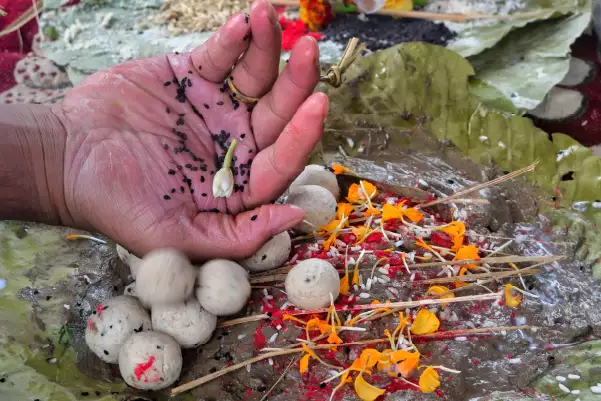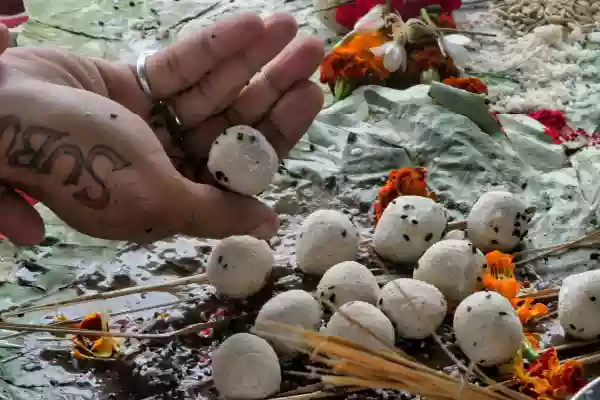Significance of Pind Daan in Gaya
Pind Daan is a time-honoured Hindu ritual, a bridge between the living and the departed, symbolizing the profound respect and reverence Hindus have for their ancestors.

The city of Gaya, located in Bihar, India, stands as the epicentre for this ritual, drawing thousands every year. Let’s explore the intricate layers of Pind Daan’s significance and its deep-rooted connection with Gaya.
Historical and Mythological Significance of Pind Daan in Gaya
Gaya’s association with Pind Daan is steeped in ancient tales and legends. According to Hindu mythology, the demon king Gayasura practised intense penance, which alarmed the gods.

Lord Vishnu, to test his devotion, granted him a boon that turned Gaya into a pivotal place for ancestral offerings. It’s believed that performing Pind Daan in Gaya ensures that the souls of ancestors attain salvation, releasing them from the cycle of birth and rebirth.
The Ritual of Pind Daan – Significance of Pind Daan in Gaya
At its core, Pind Daan is about offering ‘Pind’—a sanctified mixture of rice, sesame seeds, and cow’s milk—to the ancestors. This symbolic offering is thought to nourish the souls of the departed, ensuring their peace and well-being in the afterlife.

Conducted by the eldest son or a male family member, the ritual is a solemn affair, with priests guiding the process through specific Vedic mantras, ensuring the correct procedures are followed.
Gaya: The Spiritual Epicenter for Pind Daan
While Pind Daan rituals are observed across various parts of India, Gaya holds unparalleled significance. The Vishnupad Temple, an ancient temple situated on the banks of the Falgu River, is the primary site for Pind Daan in Gaya.

The temple’s sanctity, combined with the city’s mythological importance, makes Gaya the most sought-after destination for this ritual. Devotees believe that the very soil of Gaya has the power to amplify the effects of the ritual, ensuring ancestors achieve Moksha (ultimate liberation).
The Annual Pitru Paksha
Pitru Paksha, a 16-day period in the Hindu lunar calendar, is considered the most auspicious time for Pind Daan. During this phase, the city of Gaya is abuzz with spiritual energy, witnessing a surge of devotees from all corners of the country. The belief is that offerings made during this period hold special significance, ensuring maximum benefit for the departed souls.
Spiritual and Emotional Significance
Beyond the ritualistic aspects, Pind Daan resonates deeply on an emotional level. It offers individuals a moment to pause, reflect, and express gratitude towards their ancestors. It’s a journey of introspection, where one acknowledges the sacrifices of those who came before and seeks their blessings for future generations. This ritual strengthens the bond between generations, emphasizing the cyclical nature of life and death.
Socio-Cultural Impact
Over the years, Gaya has evolved into more than just a religious hub. The influx of devotees has led to a unique blend of cultures, traditions, and practices. Local businesses, artisans, and guides have flourished, making Pind Daan not just a spiritual journey but also a socio-cultural experience.
Conclusion
Pind Daan in Gaya transcends the boundaries of a mere ritual. It’s a confluence of faith, history, emotion, and culture. It serves as a poignant reminder of the Hindu belief in the eternal cycle of life, death, and rebirth. For many, a pilgrimage to Gaya is a journey of self-discovery, a quest for closure, and a deep dive into the rich tapestry of Hindu traditions and beliefs.

In essence, Pind Daan in Gaya is a symphony of the human experience. It encapsulates the joys, sorrows, quests, and realizations that define our existence. It’s a ritual that, in its depth and breadth, captures the very essence of what it means to be human, to love, to remember, and to seek.
